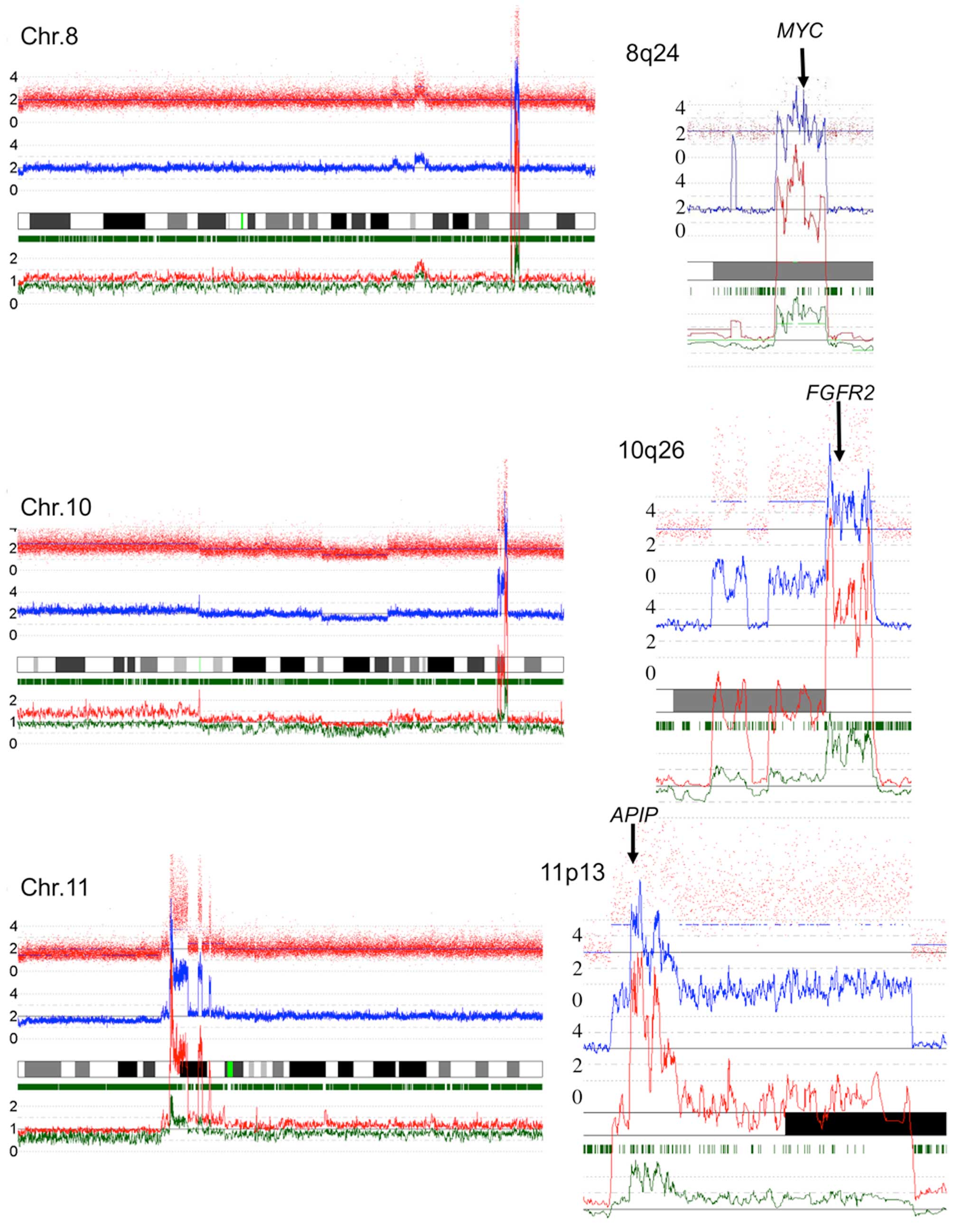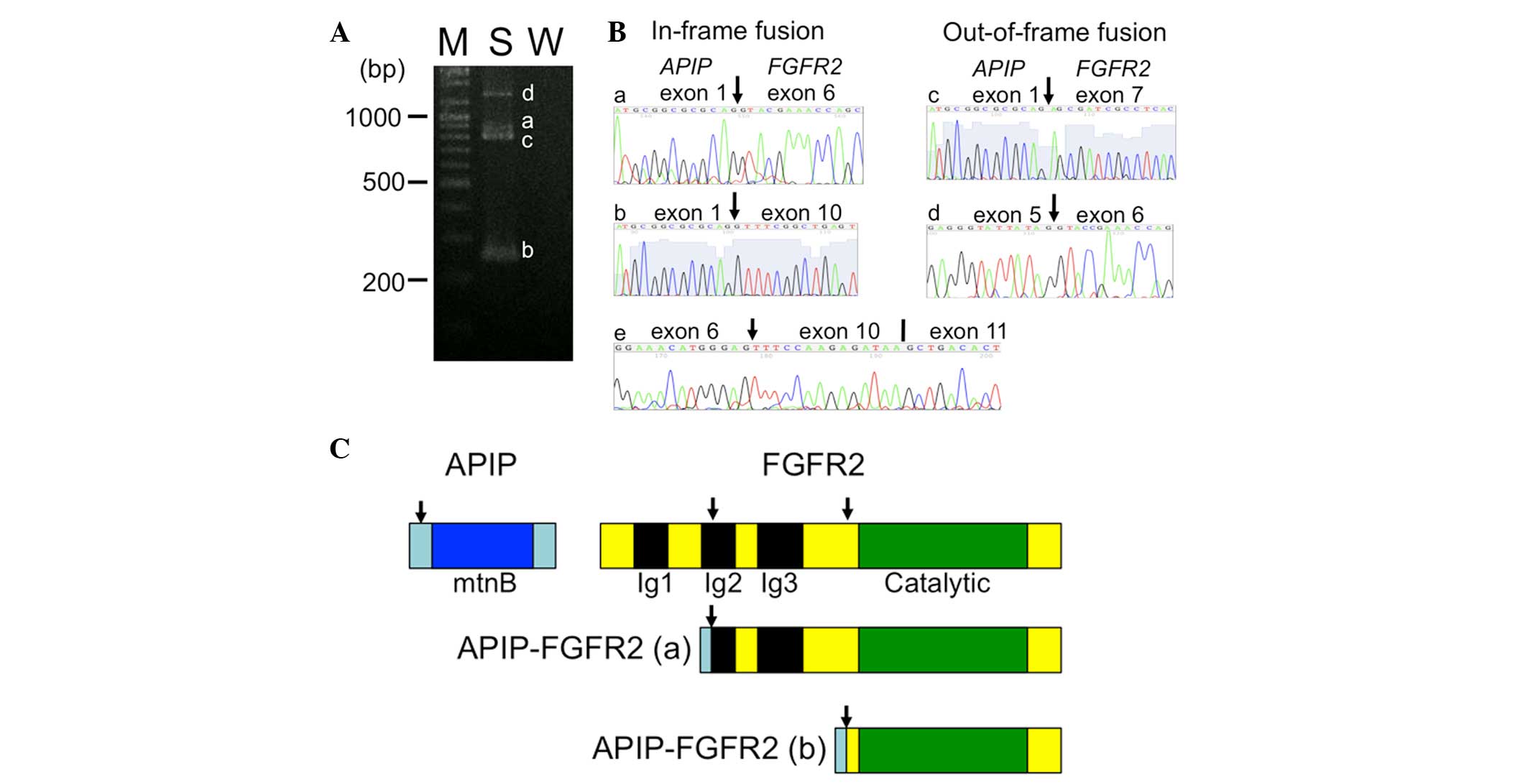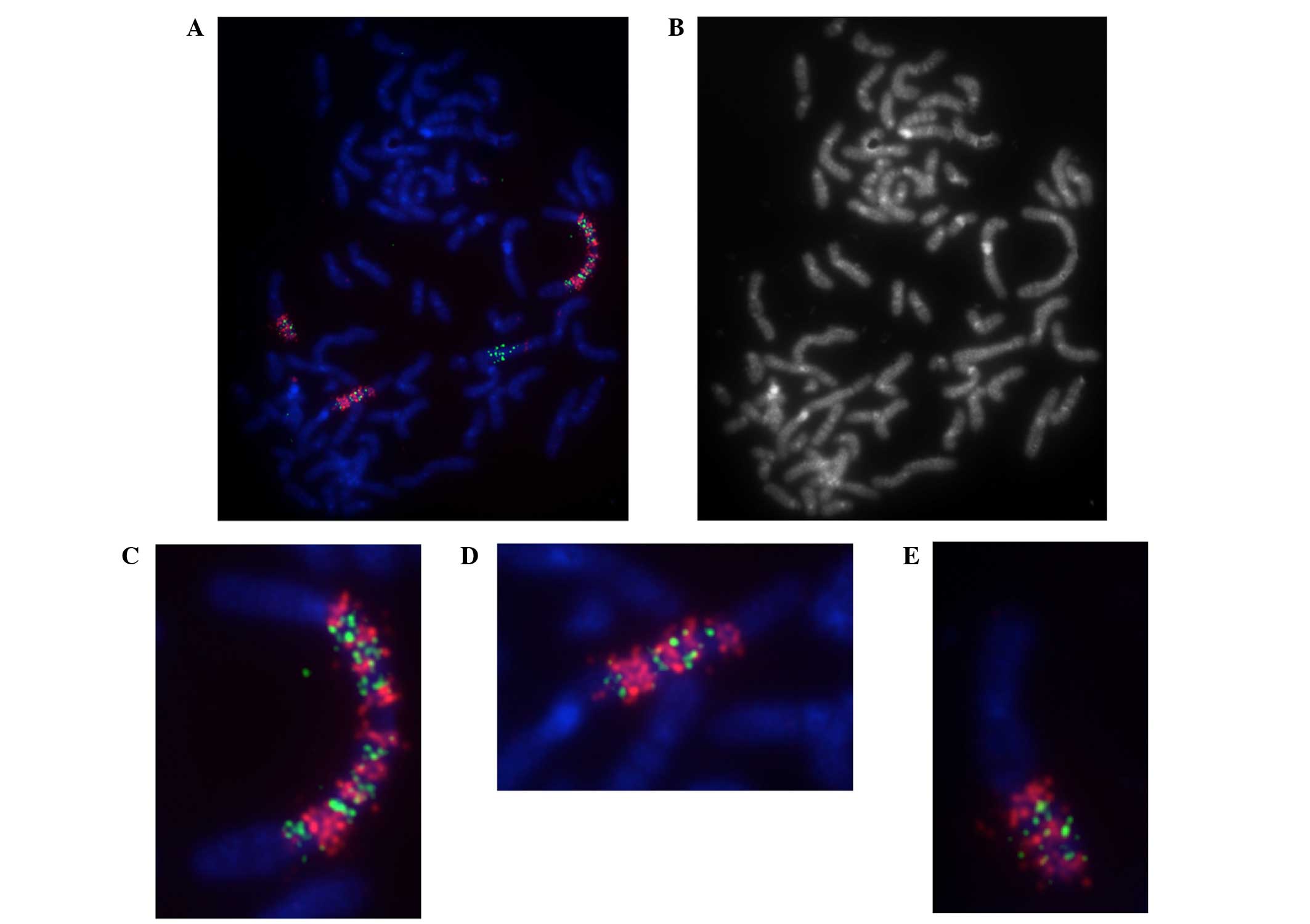|
1
|
Hartgrink HH, Jansen EP, van Grieken NC
and van de Velde CJ: Gastric cancer. Lancet. 374:477–490. 2009.
View Article : Google Scholar : PubMed/NCBI
|
|
2
|
Jemal A, Bray F, Center MM, Ferlay J, Ward
E and Forman D: Global cancer statistics. CA Cancer J Clin.
61:69–90. 2011. View Article : Google Scholar : PubMed/NCBI
|
|
3
|
Nakatsuru S, Yanagisawa A, Ichii S, Tahara
E, Kato Y, Nakamura Y and Horii A: Somatic mutation of the APC gene
in gastric cancer: Frequent mutations in very well differentiated
adenocarcinoma and signet-ring cell carcinoma. Hum Mol Genet.
1:559–563. 1992. View Article : Google Scholar : PubMed/NCBI
|
|
4
|
Deng N, Goh LK, Wang H, Das K, Tao J, Tan
IB, Zhang S, Lee M, Wu J, Lim KH, et al: A comprehensive survey of
genomic alterations in gastric cancer reveals systematic patterns
of molecular exclusivity and co-occurrence among distinct
therapeutic targets. Gut. 61:673–684. 2012. View Article : Google Scholar : PubMed/NCBI
|
|
5
|
Wei J, Noto J, Zaika E, Romero-Gallo J,
Correa P, El-Rifai W, Peek RM and Zaika A: Pathogenic bacterium
Helicobacter pylori alters the expression profile of p53 protein
isoforms and p53 response to cellular stresses. Proc Natl Acad Sci
USA. 109:E2543–E2550. 2012. View Article : Google Scholar : PubMed/NCBI
|
|
6
|
Li QL, Ito K, Sakakura C, Fukamachi H,
Inoue KI, Chi XZ, Lee KY, Nomura S, Lee CW, Han SB, et al: Causal
relationship between the loss of RUNX3 expression and gastric
cancer. Cell. 109:113–124. 2002. View Article : Google Scholar : PubMed/NCBI
|
|
7
|
Guilford P, Hopkins J, Harraway J, McLeod
M, McLeod N, Harawira P, Taite H, Scoular R, Miller A and Reeve AE:
E-cadherin germline mutations in familial gastric cancer. Nature.
392:402–405. 1998. View
Article : Google Scholar : PubMed/NCBI
|
|
8
|
Park WS, Oh RR, Park JY, Lee SH, Shin MS,
Kim YS, Kim SY, Lee HK, Kim PJ, Oh ST, et al: Frequent somatic
mutations of the beta-catenin gene in intestinal-type gastric
cancer. Cancer Res. 59:4257–4260. 1999.PubMed/NCBI
|
|
9
|
Choi JS, Seo J, Jung EJ, Kim EJ, Lee GK
and Kim WH: c-MYC amplification in mucinous gastric carcinoma: A
possible genetic alteration leading to deeply invasive tumors.
Anticancer Res. 32:5031–5037. 2012.PubMed/NCBI
|
|
10
|
Hattori Y, Odagiri H, Nakatani H, Miyagawa
K, Naito K, Sakamoto H, Katoh O, Yoshida T, Sugimura T and Terada
M: K-sam, an amplified gene in stomach cancer, is a member of the
heparin-binding growth factor receptor genes. Proc Natl Acad Sci
USA. 87:5983–5987. 1990. View Article : Google Scholar : PubMed/NCBI
|
|
11
|
Kuniyasu H, Yasui W, Kitadai Y, Yokozaki
H, Ito H and Tahara E: Frequent amplification of the c-met gene in
scirrhous type stomach cancer. Biochem Biophys Res Commun.
189:227–232. 1992. View Article : Google Scholar : PubMed/NCBI
|
|
12
|
Kameda T, Yasui W, Yoshida K, Tsujino T,
Nakayama H, Ito M, Ito H and Tahara E: Expression of ERBB2 in human
gastric carcinomas: Relationship between p185ERBB2 expression and
the gene amplification. Cancer Res. 50:8002–8009. 1990.PubMed/NCBI
|
|
13
|
Palanisamy N, Ateeq B, Kalyana-Sundaram S,
Pflueger D, Ramnarayanan K, Shankar S, Han B, Cao Q, Cao X, Suleman
K, et al: Rearrangements of the RAF kinase pathway in prostate
cancer, gastric cancer and melanoma. Nat Med. 16:793–798. 2010.
View Article : Google Scholar : PubMed/NCBI
|
|
14
|
Kim HP, Cho GA, Han SW, Shin JY, Jeong EG,
Song SH, Lee WC, Lee KH, Bang D, Seo JS, et al: Novel fusion
transcripts in human gastric cancer revealed by transcriptome
analysis. Oncogene. 33:5434–5441. 2014. View Article : Google Scholar : PubMed/NCBI
|
|
15
|
Yun SM, Yoon K, Lee S, Kim E, Kong SH,
Choe J, Kang JM, Han TS, Kim P, Choi Y, et al: PPP1R1B-STARD3
chimeric fusion transcript in human gastric cancer promotes
tumorigenesis through activation of PI3K/AKT signaling. Oncogene.
33:5341–5347. 2014. View Article : Google Scholar : PubMed/NCBI
|
|
16
|
Tao J, Deng NT, Ramnarayanan K, Huang B,
Oh HK, Leong SH, Lim SS, Tan IB, Ooi CH, Wu J, et al: CD44-SLC1A2
gene fusions in gastric cancer. Sci Transl Med. 3:77ra30. 2011.
|
|
17
|
Yamashita Y, Nishida K, Okuda T, Nomura K,
Matsumoto Y, Mitsufuji S, Horiike S, Hata H, Sakakura C, Hagiwara
A, et al: Recurrent chromosomal rearrangements at bands 8q24 and
11q13 in gastric cancer as detected by multicolor spectral
karyotyping. World J Gastroenterol. 11:5129–5135. 2005.PubMed/NCBI
|
|
18
|
Campbell PJ, Stephens PJ, Pleasance ED,
O'Meara S, Li H, Santarius T, Stebbings LA, Leroy C, Edkins S,
Hardy C, et al: Identification of somatically acquired
rearrangements in cancer using genome-wide massively parallel
paired-end sequencing. Nat Genet. 40:722–729. 2008. View Article : Google Scholar : PubMed/NCBI
|
|
19
|
Pleasance ED, Stephens PJ, O'Meara S,
McBride DJ, Meynert A, Jones D, Lin ML, Beare D, Lau KW, Greenman
C, et al: A small-cell lung cancer genome with complex signatures
of tobacco exposure. Nature. 463:184–190. 2010. View Article : Google Scholar : PubMed/NCBI
|
|
20
|
Northcott PA, Shih DJ, Peacock J, Garzia
L, Morrissy AS, Zichner T, Stütz AM, Korshunov A, Reimand J,
Schumacher SE, et al: Subgroup-specific structural variation across
1,000 medulloblastoma genomes. Nature. 488:49–56. 2012. View Article : Google Scholar : PubMed/NCBI
|
|
21
|
Nannya Y, Sanada M, Nakazaki K, Hosoya N,
Wang L, Hangaishi A, Kurokawa M, Chiba S, Bailey DK, Kennedy GC and
Ogawa S: A robust algorithm for copy number detection using
high-density oligonucleotide single nucleotide polymorphism
genotyping arrays. Cancer Res. 65:6071–6079. 2005. View Article : Google Scholar : PubMed/NCBI
|
|
22
|
Chinen Y, Taki T, Nishida K, Shimizu D,
Okuda T, Yoshida N, Kobayashi C, Koike K, Tsuchida M, Hayashi Y and
Taniwaki M: Identification of the novel AML1 fusion partner gene,
LAF4, a fusion partner of MLL, in childhood T-cell acute
lymphoblastic leukemia with t(2;21)(q11;q22) by bubble PCR method
for cDNA. Oncogene. 27:2249–2256. 2008. View Article : Google Scholar : PubMed/NCBI
|
|
23
|
Nagoshi H, Taki T, Hanamura I, Nitta M,
Otsuki T, Nishida K, Okuda K, Sakamoto N, Kobayashi S,
Yamamoto-Sugitani M, et al: Frequent PVT1 rearrangement and novel
chimeric genes PVT1-NBEA and PVT1-WWOX occur in multiple myeloma
with 8q24 abnormality. Cancer Res. 72:4954–4962. 2012. View Article : Google Scholar : PubMed/NCBI
|
|
24
|
Holbrook JD, Parker JS, Gallagher KT,
Halsey WS, Hughes AM, Weigman VJ, Lebowitz PF and Kumar R: Deep
sequencing of gastric carcinoma reveals somatic mutations relevant
to personalized medicine. J Transl Med. 9:1192011. View Article : Google Scholar : PubMed/NCBI
|
|
25
|
Korbel JO and Campbell PJ: Criteria for
inference of chromothripsis in cancer genomes. Cell. 152:1226–1236.
2013. View Article : Google Scholar : PubMed/NCBI
|
|
26
|
Magrangeas F, Avet-Loiseau H, Munshi NC
and Minvielle S: Chromothripsis identifies a rare and aggressive
entity among newly diagnosed multiple myeloma patients. Blood.
118:675–678. 2011. View Article : Google Scholar : PubMed/NCBI
|
|
27
|
Stephens PJ, Greenman CD, Fu B, Yang F,
Bignell GR, Mudie LJ, Pleasance ED, Lau KW, Beare D, Stebbings LA,
et al: Massive genomic rearrangement acquired in a single
catastrophic event during cancer development. Cell. 144:27–40.
2011. View Article : Google Scholar : PubMed/NCBI
|
|
28
|
Kang W, Hong SH, Lee HM, Kim NY, Lim YC,
Le le TM, Lim B, Kim HC, Kim TY, Ashida H, et al: Structural and
biochemical basis for the inhibition of cell death by APIP, a
methionine salvage enzyme. Proc Natl Acad Sci USA. 111:E54–E61.
2014. View Article : Google Scholar : PubMed/NCBI
|
|
29
|
Järvinen AK, Autio R, Haapa-Paananen S,
Wolf M, Saarela M, Grénman R, Leivo I, Kallioniemi O, Mäkitie AA
and Monni O: Identification of target genes in laryngeal squamous
cell carcinoma by high-resolution copy number and gene expression
microarray analyses. Oncogene. 25:6997–7008. 2006. View Article : Google Scholar : PubMed/NCBI
|
|
30
|
Moravcikova E, Krepela E, Prochazka J,
Rousalova I, Cermak J and Benkova K: Down-regulated expression of
apoptosis-associated genes APIP and UACA in non-small cell lung
carcinoma. Int J Oncol. 40:2111–2121. 2012.PubMed/NCBI
|
|
31
|
Nakatani H, Sakamoto H, Yoshida T, Yokota
J, Tahara E, Sugimura T and Terada M: Isolation of an amplified DNA
sequence in stomach cancer. Jpn J Cancer Res. 81:707–710. 1990.
View Article : Google Scholar : PubMed/NCBI
|
|
32
|
Xie L, Su X, Zhang L, Yin X, Tang L, Zhang
X, Xu Y, Gao Z, Liu K, Zhou M, et al: FGFR2 gene amplification in
gastric cancer predicts sensitivity to the selective FGFR inhibitor
AZD4547. Clin Cancer Res. 19:2572–2583. 2013. View Article : Google Scholar : PubMed/NCBI
|















